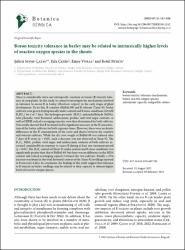Boron toxicity tolerance in barley may be related to intrinsically higher levels of reactive oxygen species in the shoots
Citation
Çatav, Ş. S., E. Çetin, E. Vural, and B. Bürün. 2023. "Boron Toxicity Tolerance in Barley may be Related to Intrinsically Higher Levels of Reactive Oxygen Species in the Shoots." Botanica Serbica 47 (1): 113-124. doi:10.2298/BOTSERB2301113C.Abstract
There is considerable intra-and interspecific variation in boron (B) toxicity tolerance in crop plants. In this study, we aimed to investigate the mechanisms involved in tolerance to excess B in barley (Hordeum vulgare) in the early stages of plant development. To do this, B-sensitive (Bülbül-89) and B-tolerant (Tarm-92) barley cultivars were grown hydroponically under control and B stress conditions (10 mM H3BO3) for 4 or 7 days. The hydrogen peroxide (H2O2), malondialdehyde (MDA), total phenolic, total flavonoid, anthocyanin, proline, and total sugar contents, as well as DPPH radical scavenging capacity, were then determined for both cultivars. Our results showed that B treatment led to significant increases in the B concentration of the barley cultivars for both exposure times. However, there were no drastic differences in the B concentration of the roots and shoots between the sensitive and tolerant cultivars. While the dry root weight of Bülbül-89 was reduced after 7 days of B stress (p < 0.05), such a decrease was not observed in Tarm-92. The H2O2, MDA, proline, total sugar, and anthocyanin contents of both cultivars increased considerably in response to excess B during at least one treatment period (p < 0.05). The H2O2 content of Tarm-92 under control and B stress conditions was significantly greater than that of Bülbül-89, but there was no difference in the MDA content and radical scavenging capacity between the two cultivars. Finally, a 35% increase was found in the total flavonoid content of the Tarm-92 seedlings exposed to B stress for 4 days. In conclusion, the findings of this study suggest that tolerance to B toxicity in barley seedlings may be related to their capacity to tolerate higher levels of reactive oxygen species


















